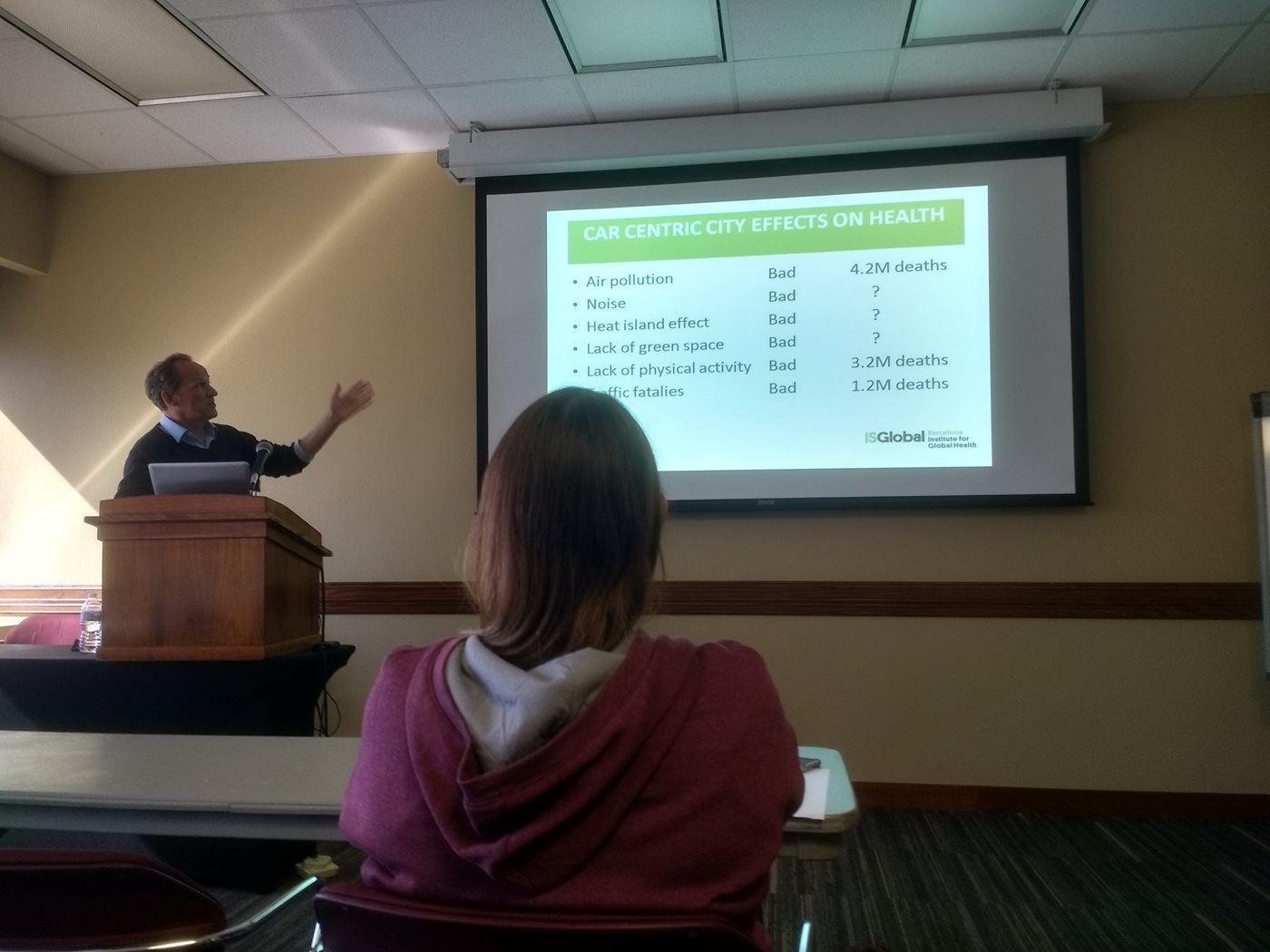Date: 12/2/2017
Author: Megan Farley, Communications and Outreach

One of the big topics under discussion here at the Institute for Sustainable Communities is the health impacts on residents of living in urban centers. Mark Nieuwenhuijsen, PhD came to Texas A&M in College Station to give us his presentation ‘Pathways to Healthy Urban Living’. In it, he addresses the current problems with modern urban living and potential ways to combat the increasing issues arising from them. He points out that with around 60 million new urban residents around the world every year, these issues are going to persist and amplify over time. Taking a more systemic approach to tackling issues like air pollution, noise, heat islands, lack of green space, and lack of physical activity is a core principle to the work he and his team are doing.
Dr. Nieuwenhuijsen, a world leading expert on environmental exposure assessment, presented his research to the institute on November 28th. His background includes epidemiology, and health/risk impact assessment with a strong focus on healthy urban living. He is the Director of the Urban Planning, Environment, and Health Initiative for ISGlobal and is currently a co-investigator on multiple European Commission (EC) funded projects and studies such as HELIX, EXPOsOMICs, PASTA, and BlueHealth. He has edited three textbooks on exposure assessment and environmental epidemiology, has coauthored more than 350 peer reviewed papers, and is releasing a book this coming March. Dr. Nieuwenhuijsen has worked at the University of California, Davis, the Imperial College London, and is now a professor at the Barcelona Institute for Global Health.
The effects of urban planning centered on cars was a notable theme in Dr. Nieuwenhuijsen’s presentation. Particularly, by how cities are built more for cars than for people. The car centric effects on health are broad and affect multiple facets of urban life. These effects range from lack of physical activity to the lack of green space and their effects on both the physical and mental wellbeing of residents.
Expanding on how this urban design is promoting a less active lifestyle for residents, Dr. Nieuwenhuijsen discussed the lack of walking as a viable mode of transportation in urban areas--with the average adult in Britain walking less than a mile a day--and how the health benefits of walking are being missed because of the car centric city structure. He demonstrated how designing cities to be friendlier towards cycling could prevent 15,801 premature deaths in 167 European cities if the use of cycling as a mode of transportation increased only to 24.7%. This small yet significant change in daily transportation would go hand in hand with an increase in green space. For which the positive health effects were compellingly demonstrated by a study showing that, on average, with just 11 more trees on city streets, mental health perception can improve in such a way that is comparable to a $10,000 increase in one’s personal income or to being 7 years younger. It was shown that greener cities would result in improved longevity, less mental health issues, better cognitive function, improved mood, and healthier babies. Additionally, greener cities would mitigate air pollution, heat, and noise pollution—all core issues needing to be tackled.
The potential solutions Dr. Nieuwenhuijsen outlined to combat the issues stemming from this car-centered city theme are land use changes, reducing the number of cars & trips, shared autonomous electric vehicles, moving towards public and active transportation, citizens participation, and visioning for a healthy urban future.
An important factor to realize the solutions mentioned above is citizen participation. With community engagement, important studies and changes could come to fruition. A good example Dr. Nieuwenhuijsen brought to our attention of this kind of participation was the Ringland project. The Ringland project is a 6 billion euro investment proposing massive sustainable urban development with a focus on the redesign of the highway system in Antwerp, Belgium. The research for this project has been organized completely by locals, executed by external academics, financed through crowdfunding, and then presented to government. This is a different kind of societal interaction between citizens, scientists, and policy makers driven by the project. An impressive four research projects were funded and executed in this fashion. They ranged from infrastructural planning & technical feasibility, mobility impact assessment, environmental impact assessment, and financial feasibility & real estate development. Four external partners participated, and it was all crowdfunded by 200,000 euros. This project is reimagining the way professionals, citizens, and policy makers work together to improve their communities.
We’ve been building an interdisciplinary team of experts here at the Institute for Sustainable Communities to tackle the various problems presented in the cities around us. Bringing together a broad team of individuals consisting of urban planners, transport planners, environmentalists, public health professionals, and economists is a focus for all of us in creating healthier, more vibrant communities. We couldn’t be happier to see experts around the globe teaming up to accomplish this kind of work and to be a part of it.
 Dr. Nieuwenhuijsen’s presentation was very exciting for us here at the Institute and we greatly appreciate him making the trip to see us all the way out here in College Station, TX. We look forward to seeing his work come to fruition, and to working with him towards helping rebuild communities for a brighter, healthier future. This first meeting marks the beginning of a fruitful collaboration moving forward.
Dr. Nieuwenhuijsen’s presentation was very exciting for us here at the Institute and we greatly appreciate him making the trip to see us all the way out here in College Station, TX. We look forward to seeing his work come to fruition, and to working with him towards helping rebuild communities for a brighter, healthier future. This first meeting marks the beginning of a fruitful collaboration moving forward.